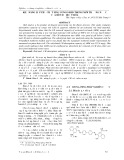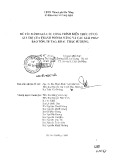
Hindawi Publishing Corporation
EURASIP Journal on Advances in Signal Processing
Volume 2009, Article ID 752818, 11 pages
doi:10.1155/2009/752818
Research Article
Detecting Distributed Network Traffic Anomaly with
Network-Wide Correlation Analysis
Li Zonglin, Hu Guangmin, Yao Xingmiao, and Yang Dan
Key Lab of Broadband Optical Fiber Transmission and Communication Networks,
University of Electronic Science and Technology of China (UESTC), Chengdu 610054, China
Correspondence should be addressed to Li Zonglin, lizonglin@uestc.edu.cn
Received 22 October 2007; Accepted 20 August 2008
Recommended by Rocky Chang
Distributed network trafficanomalyreferstoatraffic abnormal behavior involving many links of a network and caused by
the same source (e.g., DDoS attack, worm propagation). The anomaly transiting in a single link might be unnoticeable and
hard to detect, while the anomalous aggregation from many links can be prevailing, and does more harm to the networks.
Aiming at the similar features of distributed traffic anomaly on many links, this paper proposes a network-wide detection
method by performing anomalous correlation analysis of traffic signals’ instantaneous parameters. In our method, traffic signals’
instantaneous parameters are firstly computed, and their network-wide anomalous space is then extracted via traffic prediction.
Finally, an anomaly is detected by a global correlation coefficient of anomalous space. Our evaluation using Abilene traffictraces
demonstrates the excellent performance of this approach for distributed traffic anomaly detection.
Copyright © 2009 Li Zonglin et al. This is an open access article distributed under the Creative Commons Attribution License,
which permits unrestricted use, distribution, and reproduction in any medium, provided the original work is properly cited.
1. Introduction
Network traffic anomaly is referred to as a situation such that
traffic deviates from its normal behavior, while distributed
network traffic anomaly is a trafficabnormalbehavior
involving multiple links of a network and caused by the same
source. There are many reasons that can cause distributed
network trafficanomaly,suchasDDoSattack,flashcrowd,
sudden shifts in traffic, worm propagation, network failure,
network outages, and so forth. Any of these anomalies will
seriously impact the performance of network.
Usually, there are not any obvious features of anomalies
in individual links for distributed network trafficanomaly,
that is, compared with background trafficofbackbone
network, even its normal changes, anomalous trafficmay
be unnoticeable so that detection based on information
collected from single link is very difficult. However, the
sum of anomalous traffic on many links can be prevailing.
If we put multitraffic singles together and apply network-
wide anomaly detection to them, the relationship between
traffic would help to reveal anomaly. Principle component
analysis (PCA) is an existing statistical-analysis technique;
Lakhina et al. [1,2] applied it as a network-wide detection
method to the field of traffic anomaly detection. It follows
that decomposing overall traffic into two disjoint parts based
on correlation across links or origin-destination (OD) flows,
respectively, corresponds to normal space and anomalous
space. Traffic with less correlation is considered as anomalous
space, the energy of anomalous space; is then compared with
a threshold to diagnosis anomaly.
The distributed traffic anomalies caused by the same
source usually have some similar features in time or
frequency domain. These similarities contribute to strong
correlation between anomalous flows. Since PCA-based
methods deal with the anomalous space that lacks correla-
tion, they are prone to suffer from false negative. Although
the volume of individual anomaly is small, anomalous
flows in many links exhibit inherent correlations. This fact
should be useful for detection. Drawing on the change of
correlation between network-wide anomalous space lends
itself to bypass the limitation of PCA-based methods. In
this paper, we propose a method to detect distributed
traffic anomaly with network-wide correlation analysis of
instantaneous parameters. First traffic signals’ instantaneous






























